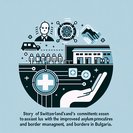
From 1 November 2025, the Swiss State Secretariat for Migration (SEM) has started applying a new, region-based assessment to every fresh request for temporary protection under the so-called “S permit”. The Federal Council adopted the change on 8 October after Parliament asked the government to distinguish between applicants coming from areas of active hostilities and those from comparatively safe regions of western Ukraine. Under the new rule, applicants whose last residence was in the oblasts of Volyn, Rivne, Lviv, Ternopil, Zakarpattia, Ivano-Frankivsk or Chernivtsi are presumed able to return safely and therefore no longer qualify automatically for status S.
The temporary protection regime was created in March 2022 so that people fleeing the war could take up residence and employment without going through a full asylum procedure. By September 2025 more than 68,000 Ukrainians held the permit in Switzerland, many of them working in health care, hospitality and IT. The government has simultaneously extended all existing S-permits until at least 4 March 2027, giving current holders legal certainty while signalling a tighter approach for new arrivals.
![Switzerland introduces region-based test for Ukrainian ‘S’ protection status]()
For employers the change means that staff hired under protection S keep their full right to live and work, but future recruits coming from Ukraine may need an ordinary asylum decision or a work authorisation if they come from the listed western oblasts. Mobility managers should therefore review talent-sourcing plans, especially for project-based IT and engineering roles that have relied on Ukrainian specialists since 2022. Recruitment lead-times could lengthen because ordinary asylum and work-permit channels involve cantonal labour-market tests.
Human-resource teams should also brief Ukrainian employees on the new 15-day travel limit: from 1 November holders of an S-permit may return to Ukraine for only 15 days in any six-month period, down from 15 days per quarter. Journeys exceeding the allowance risk cancellation of the permit at re-entry. Companies offering paid “home-leave” trips should adjust policies accordingly.
Although Switzerland’s approach is more restrictive than the EU’s blanket Temporary Protection Directive, it may foreshadow a broader European trend towards differentiated protection. Mobility advisers expect other Schengen members to tighten eligibility in 2026 as reconstruction in parts of Ukraine gathers pace and labour-market pressure grows across the bloc.
The temporary protection regime was created in March 2022 so that people fleeing the war could take up residence and employment without going through a full asylum procedure. By September 2025 more than 68,000 Ukrainians held the permit in Switzerland, many of them working in health care, hospitality and IT. The government has simultaneously extended all existing S-permits until at least 4 March 2027, giving current holders legal certainty while signalling a tighter approach for new arrivals.

For employers the change means that staff hired under protection S keep their full right to live and work, but future recruits coming from Ukraine may need an ordinary asylum decision or a work authorisation if they come from the listed western oblasts. Mobility managers should therefore review talent-sourcing plans, especially for project-based IT and engineering roles that have relied on Ukrainian specialists since 2022. Recruitment lead-times could lengthen because ordinary asylum and work-permit channels involve cantonal labour-market tests.
Human-resource teams should also brief Ukrainian employees on the new 15-day travel limit: from 1 November holders of an S-permit may return to Ukraine for only 15 days in any six-month period, down from 15 days per quarter. Journeys exceeding the allowance risk cancellation of the permit at re-entry. Companies offering paid “home-leave” trips should adjust policies accordingly.
Although Switzerland’s approach is more restrictive than the EU’s blanket Temporary Protection Directive, it may foreshadow a broader European trend towards differentiated protection. Mobility advisers expect other Schengen members to tighten eligibility in 2026 as reconstruction in parts of Ukraine gathers pace and labour-market pressure grows across the bloc.












